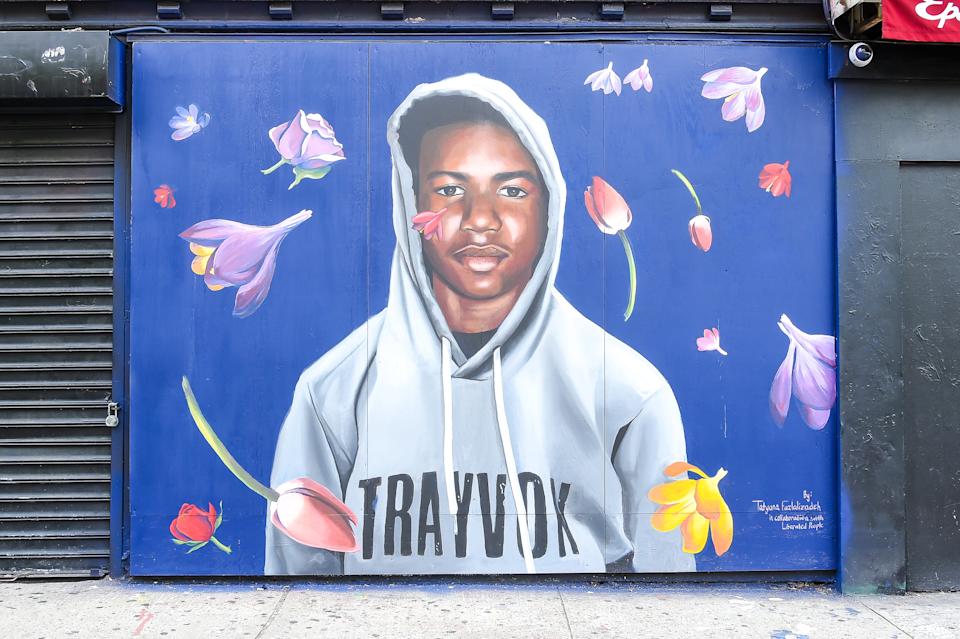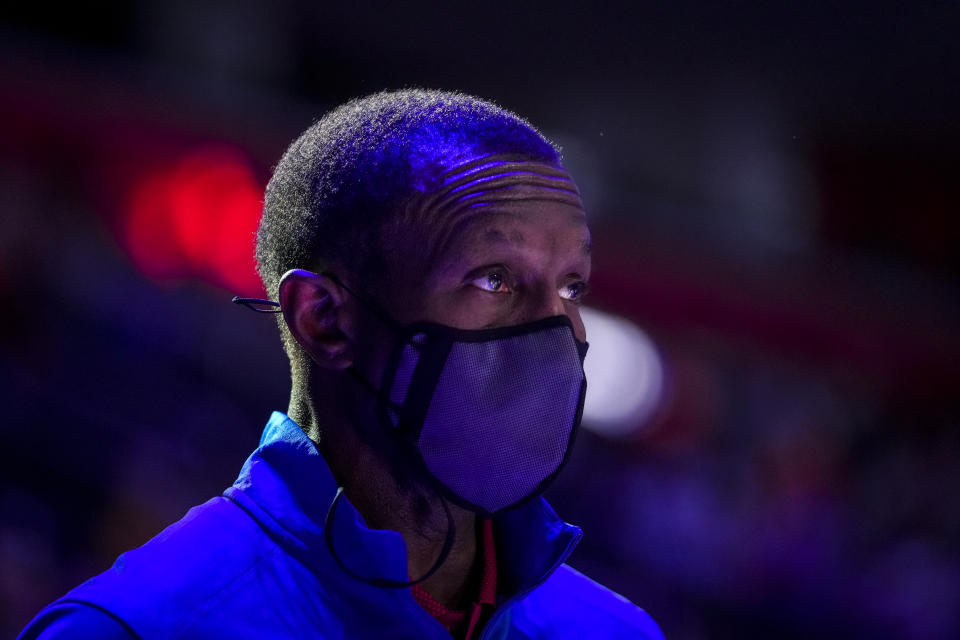“It was the Emmett Till of our time.”
The words Detroit Pistons forward Jerami Grant told Yahoo Sports are chilling, thought-provoking and pausing.
Till’s death in 1955 became a catalyst for the civil rights movement. Till, a 14-year-old from Chicago, was accused of whistling at a white woman in Mississippi. It was a high crime in the Jim Crow South, and Till was brutally killed by two white men, who dumped his body in a nearby river.
Grant was still in college, not a full-grown NBA player when a Florida teenager was killed 10 years ago. Trayvon Martin, a 17-year-old in Sanford, was stalked, confronted and then killed by George Zimmerman on his way home that Sunday in February 2012. Martin, robbed of a future, would be 27 years old today — barely a year younger than Grant.
Zimmerman, a neighborhood watch coordinator, believed the teenager was “suspicious” and approached Martin. The two got into a physical altercation. Zimmerman shot Martin, killing him and claimed self-defense.
Till’s casket was open at his funeral, so people could understand the graphic nature of his death. Martin’s death seemed to be a window into the graphic nature of America’s psyche.
“Learning how he was pursued, that’s what stood out about it,” Boston Celtics coach Ime Udoka told Yahoo Sports recently. “And then you come to find out it’s not a real law enforcement person [Zimmerman]. Then you hear about the 10-year anniversary, it’s shocking how fast time has gone by. And surprising how many incidents have happened since. So, that kind of shines a light on him. It makes you reflect on what’s happened in the years since.”


Udoka was a few months away from becoming an assistant with the San Antonio Spurs, recently finishing his basketball playing career. Twitter was in its infancy, parallel to NBA players who had the platform to make statements in real time as the rest of the world gathered its breath and tried to make sense of the nonsense.
Martin’s death was a first of its time in a sense — to which Grant described the fast-moving social media world that’s now commonplace, the instant reactions that formed once details began to trickle out of Florida, along with NBA players beginning to use their voices over injustice and racism.
It seems hard to fathom, but it was four years before Colin Kaepernick began his silent protest, and at least two years before Adam Silver replaced David Stern as commissioner. NBA players weren’t being told to “shut up and dribble” — but there wasn’t encouragement by much of anyone to put truth to power.
And there definitely wasn’t any corporate push to fashionably call for justice, either.
“The players got behind that,” Udoka said. “Since then, they’ve been very vocal, using their platform to shine light on things. That’s when it was put on the map.”
There wasn’t cellphone video of Martin’s death, but it seemed to foretell events to come. Myriad names roll off the tongue, a saddening stream of bodies in the streets and in jail cells with barely a modicum of justice to account. Tamir Rice, Michael Brown, Breonna Taylor, Sandra Bland and George Floyd, among others, followed. The commonality was the victims were Black and the circumstances were all preventable.
The death of this teenager stirred the nation — prompting an outburst of anger, frustration and sadness on one side, with defensiveness, prejudices and stereotypes on the other. It forced a large portion of the nation to look at itself in the mirror to confront long-held beliefs that often had very little merit.
The 2008 presidential election and mere presence of Barack Obama brought more than a few to openly claim America was in a “post-racial” society. If the pushback to Obama wasn’t enough to disprove that theory, Martin’s death and America’s reaction was a wake-up call.
It wasn’t a shock to many Black people. Parents long had discussions with their children, young and old, about getting home safely, etiquette in dealing with the police or police-like figures.
Pistons coach Dwane Casey grew up in segregated Kentucky, where the rules were spoken, “We couldn’t go in the restaurant, we had to go pick it up,” and unspoken, “You couldn’t even look at the police the wrong way, whatever they said is ‘right.’ ”
He said Martin was “assassinated.”
“From a father’s perspective, you send your son to school or to the store and something like this happens,” Casey told Yahoo Sports. “And that happened because he had a hoodie on — and he’s African American. That really sticks with you.
“I think our world is changing, but then something like that would bounce up and pop up and shock you.”


Martin’s hoodie — which he was wearing on a rainy night — became a symbol. The Miami Heat players — then the biggest cultural phenomenon in sports, led by LeBron James and Dwyane Wade — took a photo of themselves in hoodies with their heads down.
It went viral, and was the biggest statement of its time. The hoodie also seemed to bring out puzzling thoughts by others, with Dallas Mavericks owner Mark Cuban intimating he’d be unnerved by seeing someone like Martin in a hoodie — comparing it to a “white guy with a bald head and tattoos everywhere” as reason to avoid the person.
Even the late Kobe Bryant took a misstep, operating under the guise that the Heat were supporting Martin merely because he was Black, not because he was a victim.
Both Bryant and Cuban walked back their comments, and Cuban apologized to Martin’s family in the wake of Zimmerman being acquitted on second-degree murder charges. But those words, along with how Martin was characterized and villainized in his death, stung many in the Black community — particularly the athletes.
The reactions in locker rooms across the league were telling. Players were openly frustrated, wanting to vent their thoughts in a public forum for the first time in a long time. This was well before the pushback to the social movement.
“I’ve always been the person to talk about things that matter to me, whether it’s the norm or not,” Grant told Yahoo Sports. “It was more of an open discussion, people feeling like they could verbalize their feelings because it was talked about on social media and in the media.”
Casey was in a peculiar position, coaching in Canada as a Black American.
“That country was always very progressive even before we got to this point. It was a different feeling,” Casey told Yahoo Sports. “I remember friends in Toronto couldn’t believe that something like that would happen to a young man walking down the street.”
Casey gathered his team and had discussions, sharing experiences they all had that could’ve gone in the opposite direction. He currently serves on the NBA’s committee for social justice and planned to visit the White House when the Pistons went to the nation’s capital earlier this week.
“We talked about how it was wrong and how we got to work and be an example to fight against that injustice,” Casey told Yahoo Sports about his conversations with his Raptors team. “From a coach and a leader standpoint, that’s something you can’t talk about enough and bring light to.”
It created what some would term a predictable divide, while others merely found it sad. The belief that in the presence of Blackness, any white person could operate as a proxy for power and authority meant a confirmation of fears, that Black people were forever on trial, forever on guard.
It meant no amount of money could shield one from the stigma. And not even being in Canada should shake the stench of being American in the ugliest of ways.
For better or worse, it started a trend and time isn’t turning back. The Zimmerman verdict brought a collective shaking of heads from many Black players, and Black people in America.
When Floyd’s killer and complicit former police officers were convicted in Minnesota, Casey shed tears.
“We saw justice happen [after] I wasn’t really surprised about [Martin’s] killer getting off,” Casey said. “It was good with [Floyd], our justice system worked. Maybe because they had videotape.”
It wasn’t the case with Martin, but it was the first time NBA players allowed the world into their minds and souls — a light that hasn’t yet dimmed because they saw too much of themselves in a victim who couldn’t speak for himself.
